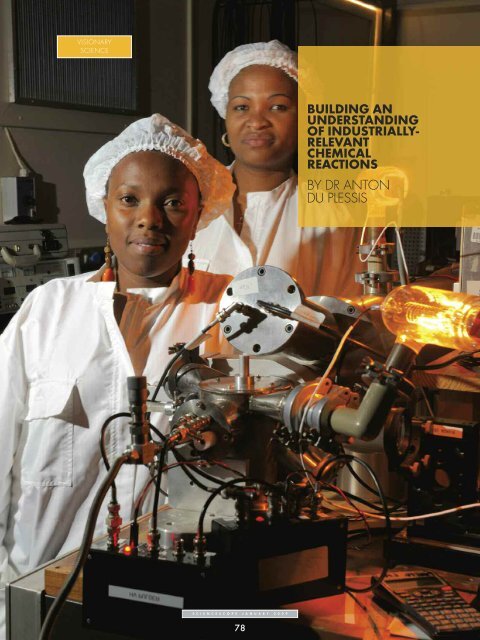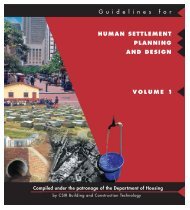Chapter 3 - CSIR
Chapter 3 - CSIR
Chapter 3 - CSIR
Create successful ePaper yourself
Turn your PDF publications into a flip-book with our unique Google optimized e-Paper software.
VISIONARYSCIENCEBUILDING ANUNDERSTANDINGOF INDUSTRIALLY-RELEVANTCHEMICALREACTIONSBY DR ANTONDU PLESSISS C I E N C E S C O P E J A N U A R Y 2 0 0 978
FEMTOSECONDSCIENCE:THENEXTFRONTIERFEMTOSECOND LASER SCIENCE is oneof the fastest growing research fields in laserscience today. It is a field of research andtechnology utilising state-of-the-art lasersystems delivering extremely short pulses withhigh peak intensities, in particular pulses inthe femtosecond regime. Over the past tenyears, these lasers have gradually becomecommercially-available, which has resulted inan upsurge in this field of research. One femtosecond(fs) is equal to one millionth of abillionth of a second (10 -15 s). This is an extremelyshort unit of time: small moleculestypically take a few hundred femtoseconds tocomplete one vibration. This is exactly one ofthe advantages of such short pulses; they areso short that they can be used to measureextremely fast processes, down to thefemtosecond regime where no other timeresolvedtechniques exist.In 2007, the <strong>CSIR</strong> established a femtosecondresearch group; and a versatile amplifiedfemtosecond laser system was installed.The <strong>CSIR</strong> uses the characteristic of the shorttemporal duration of femtosecond laserpulses to measure extremely fast biologicaland chemical processes. A technique calledpump probe spectroscopy is used to measureabsorption changes in liquid samples as fastas 150 femtoseconds, a first of its kind inAfrica. Another major advantage of thistechnology is the extremely high peakpowers that are obtained using these shortpulses – allowing for a wide variety ofinteresting and novel applications.For example, the technique of laser inducedbreakdown spectroscopy, which is an establishedlaser spectroscopic technique for measuringtrace quantities of elements in anymaterial down to the parts-per-million (ppm)level in real time and without sample preparation,is made even more sensitive and accuratewhen using femtosecond laser pulses.One of the many advantages of this laser isthe low mass ablation rates making precisionsampling and depth profiling a reality. This iscurrently an active field of research in thefemtosecond laboratory and forms part of aproject for an industrial client, measuringtrace metal concentrations in thin layers as afunction of depth into the layer. This cannotbe performed with other techniques withoutsample preparation and in a non-contactmeasurement setup.Other active fields of research include laserionisation time of flight mass spectroscopy,laser ablation and micromachining, and laserpulse shaping and diagnostics. This researchis currently being undertaken in a combinedeffort to make a long-term impact in thisexciting field and in particular in coherentcontrol, but also to make an impact in theshort-term by applying this technology tospecific industrial problems.Using femtosecond laser techniques, one canactually control chemical and biological reactions,a technique called coherent control.This is made possible through the couplingbetween frequency and time by the Heisenberguncertainty principle. Applying this principleto, for example, 100 femtosecond laserpulses implies that these pulses must have awavelength bandwidth or ‘spread’ of about10 nanometres; entirely different from typicallaser sources that are monochromatic (verynarrow wavelength spread). This characteristicof femtosecond lasers makes it possible toexcite molecules at exactly the same time butinto adjacent excited energy levels, which iscalled a coherent excitation or wavepacket.Such a wavepacket after excitation coherentlyvibrates in the excited state and maythen be manipulated further into an ionisedstate, a dissociating state or some otherprocess can be initiated. By changing thelaser pulse parameters and timing of subsequentpulses it actually becomes possible tocontrol molecular processes. In principle,this means that chemical reactions may becontrolled, for example a reaction that canproduce either product A or B may becontrolled to produce selectively more ofA or more of B by simply changing certainlaser parameters in real time. For example,in a chemical deposition process generatingthin layers of material, the deposition processcould possibly be improved in real time bycoherent control techniques.According to <strong>CSIR</strong> Interim Group Executive,Dr Thulani Dlamini, “The <strong>CSIR</strong> has seen thepotential of this new technology and intendsmaking an impact by becoming a worldleader in niche application areas of femtosecondscience. Our research is alreadylooking at building an understanding of industrially-relevantchemical reactions andnovel approaches to materials processing.”Enquiries:Dr Anton du Plessisadplessis2@csir.co.zaS C I E N C E S C O P E J A N U A R Y 2 0 0 979
VISIONARYSCIENCEDr Kevin Wellingtoninvestigates multipleuses for an emergingclass of enzymes foundin fungi, plants andmicro-organismsGREENCHEMISTRY:PROMOTING ANENVIRONMENTALLY-FRIENDLY INDUSTRYIN THE AGE OF A GREEN REVOLUTION AND EFFORTS TO SLOW THE EFFECTSOF GLOBAL WARMING AND CLIMATE CHANGE, THE INDUSTRIAL SECTOR ISCHALLENGED TO PLAY ITS FAIR SHARE IN PRESERVING THE EARTH AS WE KNOW IT.Laccases are a class of enzymes that aregradually attracting interest for their potentialin health and environmental research.Dr Kevin Wellington, a <strong>CSIR</strong> bioscientist, isconducting novel research into the applicationof these enzymes in organic synthesisreactions to replace environmentallyunfriendlychemical oxidants. This couldeventually go a long way in changing theeffect of industry, especially the chemicaland pharmaceutical industry, on theenvironment.Laccases are defined as copper-containingoxidase enzymes found in plants, fungi andmicro-organisms. Wellington is sourcing laccasesfrom fungi for his study. “Laccases areinternationally popular for bioremediation.Much research has been done to look atpossible applications but I have not yetheard of it used in industrial organic synthesisapplications,” he says.In addition to developing ‘green’ methods ofsynthesis, he is investigating the use of laccasesas reaction catalysts to access compoundswith anti-bacterial, anti-cancer andanti-tuberculosis (TB) activity – work thatbegan in 2007. Wellington is modifyingselected first-line TB drugs in an effort tocircumvent resistance to these drugs byadding a part that has never been addedbefore.“The basis for our research is to provide answersto our questions: ‘What can we dowith laccases – can we use them to replaceconventional chemical oxidants? Can we,through the use of laccases, access compoundswith some pharmaceutical value? Atthe <strong>CSIR</strong> our aim is to eventually synthesisecompounds that can be further developed toachieve enhanced activity against TB andcancer,” he explains.So far positive results have been obtainedwith regard to anti-cancer activity. “We hadsome success in the screening conducted inthe cancer screening laboratory at the <strong>CSIR</strong>.Laccase products also inhibit the growth ofsome non-pathogenic bacteria, however, weneed to do further studies to determine thecytotoxicity of these compounds.”According to Wellington, some very specifictraits give enzymes an edge over chemicaloxidants. Enzymes are substrate and regionspecificand can be used at room temperature;reactions performed with enzymesrequire no or less organic solvent; enzymesare natural and if one has to dispose ofthem, are environmentally-friendly whilechemical oxidants are often not.Wellington maintains that research intolaccases is very much visionary. “In termsof its applications it’s more academic at thisstage. The broadening of its applications,particularly in organic synthesis, is relativelynew.” – Asha SpeckmanEnquiries:Dr Kevin Wellingtonkwellington@csir.co.zaS C I E N C E S C O P E J A N U A R Y 2 0 0 980
A NOVEL,PLANT-BASEDRABIESANTIBODYIN THEPIPELINEHUMAN OR EQUINE BLOOD PLASMAhas for generations sufficed as the majorsource of rabies immunoglobulin (RIG), apassive immunisation antibody administered incombination with a vaccine to rabies victims.Critical shortages of donor blood countrywideand common outbreak of rabies threaten thesupply of this vital antibody. This spurred <strong>CSIR</strong>plant biotechnologists to investigate a promisingalternative harvested from plants as well as theblueprint for a new pharmaceutical company.Plants have been the source of many therapeuticproteins to treat diseases such as cancer and arelucrative natural factories for the production ofhealth molecules due to their similarity to humancells and yeasts, among other reasons. Theyread the same genetic code and can assemble,fold and secrete complex proteins while offeringthe pharmaceutical industry one of the trendiestand economical options to grow safe, pure andhighly efficacious therapeutics.According to the National Bioproducts Institute,the sole manufacturer and supplier of RIG,stocks of its anti-rabies product, Rabigam,reached critical shortage following outbreaks ofrabies in KwaZulu-Natal, Mpumalanga andLimpopo. Not only is rabies a problem in SouthAfrica, it is also a challenge to Indian andChinese health authorities, explains Dr EreckChakauya, who manages the <strong>CSIR</strong>’s project.“Statistics produced in 2008 reveal that about450 000 cases and 50 000 laboratory confirmeddeaths are reported per annum in mainlyAfrica and Asia. More than 10 million peopleworldwide are vaccinated annually againstrabies. The scope of this disease is growing,however, due to poor human health systems,inadequate prevention regimes and limitedinfrastructure for post mortem and laboratoryanalysis. In Africa especially, it is estimated thatthe number of human fatalities from rabies maybe 20-100 times higher than reported,” saysChakauya.Rabies is a viral disease occurring in mammalsand is usually spread through the bite of a rabidanimal. If not treated immediately, it can infectthe central nervous system, institute inflammationof the brain and ultimately result in death.In mid-2008 the <strong>CSIR</strong> made a breakthroughwhen experiments to produce an antibody inplants against rabies passed several tests in thelaboratory.Dr Ereck Chakauya ismasterminding theestablishment of anew pharmaceuticalcompany for theproduction of plantbasedpharmaceuticals“Our in vitro data suggested that the plant-mademonoclonal antibody neutralises most rabiesstrains,” reveals Dr Rachel Chikwamba, theprincipal investigator. Samples were subsequentlyforwarded to the collaborative partnerfor trials in animal models.Antibodies are naturally occurring molecules thatbind to and neutralise antigens and are classifiedas either polyclonal or monoclonal. The latterantibody is programmed to recognise andneutralise specific antigens.“In South Africa, this is the first attempt that weare aware of to make the antibody in plants. Theconcept has been tested in laboratories overseaswith one currently in phase two clinical trials.What makes the <strong>CSIR</strong> work unique is that we usea novel monoclonal antibody donated by theWorld Health Organization on a humanitarianbasis through our affiliation to the internationalPharmaplanta Consortium,” he explains.The <strong>CSIR</strong> generated genetically modifiedtobacco plants expressing the anti-rabiesantibody using Agrobacterium tumefaciens,a bacterium commonly used to introduce genesinto plants.According to Chakauya, monoclonal antibodiesare one of the fastest growing classes of therapeuticswith 200 products in clinical evaluationand many more in preclinical development.Worldwide, the market is expected to reach$49 billion by 2013, owing to a growth rate of11,5% annually. In Europe alone the monoclonalantibody market is guestimated to grow at acombined growth rate of 34,1% to $11,4 billionby 2011, mainly fuelled by the need for safe andeffective treatment alternatives to autoimmuneand inflammatory disorders.The <strong>CSIR</strong> plans to contribute to this marketthrough the establishment of a spin-off company,GreenPharm, which will initially focus onsupplying the antibody to the South Africanmarket. This, according to Chakauya, alsopromises to become a reality.– Asha SpeckmanEnquiries:Dr Ereck Chakauyaechakauya@csir.co.zaS C I E N C E S C O P E J A N U A R Y 2 0 0 981
















